Enhancing Manufacturability of SU-8 Piezoelectric Composite Films for Microsystem Applications
Abstract
1. Introduction
2. Materials and Methods
2.1. Fabrication of Composite Films
2.2. Characterization of Films
3. Results and Discussion
3.1. Manufacturing of SU-8 Composites
3.2. Characterization of Composite Films
3.3. Multiple Layer Composite Film Characterization
3.4. Integration of Composite Film into Device
4. Conclusions
Author Contributions
Funding
Data Availability Statement
Acknowledgments
Conflicts of Interest
References
- Eltouby, P.; Shyha, I.; Li, C.; Khaliq, J. Factors affecting the piezoelectric performance of ceramic-polymer composites: A comprehensive review. Ceram. Int. 2021, 47, 17813–17825. [Google Scholar] [CrossRef]
- Wu, S.; Hu, W.; Ze, Q.; Sitti, M.; Zhao, R. Multifunctional magnetic soft composites: A review. Multifunct. Mater. 2020, 3, 042003. [Google Scholar] [CrossRef]
- Ramadan, K.S.; Sameoto, D.; Evoy, S. A review of piezoelectric polymers as functional materials for electromechanical transducers. Smart Mater. Struct. 2014, 23, 033001. [Google Scholar] [CrossRef]
- Ducrot, P.-H.; Dufour, I.; Ayela, C. Optimization of PVDF-TrFE processing conditions for the fabrication of organic MEMS resonators. Sci. Rep. 2016, 6, 19426. [Google Scholar] [CrossRef] [PubMed]
- Mohammadpourfazeli, S.; Arash, S.; Ansari, A.; Yang, S.; Mallick, K.; Bagherzadeh, R. Future prospects and recent developments of polyvinylidene fluoride (PVDF) piezoelectric polymer; fabrication methods, structure, and electro-mechanical properties. RSC Adv. 2023, 13, 370–387. [Google Scholar] [CrossRef] [PubMed]
- Toprak, A.; Tigli, O. MEMS scale PVDF-TrFE-based piezoelectric energy harvesters. J. Microelectromechanical Syst. 2015, 24, 1989–1997. [Google Scholar] [CrossRef]
- Sappati, K.K.; Bhadra, S. Piezoelectric Polymer and Paper Substrates: A Review. Sensors 2018, 18, 3605. [Google Scholar] [CrossRef] [PubMed]
- Smith, M.; Kar-Narayan, S. Piezoelectric polymers: Theory, challenges and opportunities. Int. Mater. Rev. 2022, 67, 65–88. [Google Scholar] [CrossRef]
- Duggina, M.; Jackson, N. Converting Parylene C into a Thin Film Piezoelectric Material. In Proceedings of the 2021 IEEE 16th Nanotechnology Materials and Devices Conference (NMDC), Vancouver, BC, Canada, 12–15 December 2021; pp. 1–5. [Google Scholar]
- Fukada, E. Recent developments of polar piezoelectric polymers. IEEE Trans. Dielectr. Electr. Insul. 2006, 13, 1110–1119. [Google Scholar] [CrossRef]
- Jackson, N.; Kunwar, D. Parylene-N as a high Temperature thin Film Piezoelectric Material. In Proceedings of the 2023 IEEE 36th International Conference on Micro Electro Mechanical Systems (MEMS), Munich, Germany, 15–19 January 2023; pp. 617–620. [Google Scholar]
- Kim, J.Y.-H.; Cheng, A.; Tai, Y.-C. Parylene-C as a piezoelectric material. In Proceedings of the 2011 IEEE 24th International Conference on Micro Electro Mechanical Systems, Cancun, Mexico, 23–27 January 2011; pp. 473–476. [Google Scholar]
- Algieri, L.; Todaro, M.T.; Guido, F.; Mastronardi, V.; Desmaële, D.; Qualtieri, A.; Giannini, C.; Sibillano, T.; De Vittorio, M. Flexible piezoelectric energy-harvesting exploiting biocompatible AlN thin films grown onto spin-coated polyimide layers. ACS Appl. Energy Mater. 2018, 1, 5203–5210. [Google Scholar] [CrossRef]
- Jackson, N.; Keeney, L.; Mathewson, A. Flexible-CMOS and biocompatible piezoelectric AlN material for MEMS applications. Smart Mater. Struct. 2013, 22, 115033. [Google Scholar] [CrossRef]
- Jackson, N.; Mathewson, A. Enhancing the piezoelectric properties of flexible hybrid AlN materials using semi-crystalline parylene. Smart Mater. Struct. 2017, 26, 045005. [Google Scholar] [CrossRef]
- Lamanna, L.; Rizzi, F.; Guido, F.; Algieri, L.; Marras, S.; Mastronardi, V.M.; Qualtieri, A.; De Vittorio, M. Flexible and transparent aluminum-nitride-based surface-acoustic-wave device on polymeric polyethylene naphthalate. Adv. Electron. Mater. 2019, 5, 1900095. [Google Scholar] [CrossRef]
- Wu, Y.; Ma, Y.; Zheng, H.; Ramakrishna, S. Piezoelectric materials for flexible and wearable electronics: A review. Mater. Des. 2021, 211, 110164. [Google Scholar] [CrossRef]
- Arash, B.; Wang, Q.; Varadan, V. Mechanical properties of carbon nanotube/polymer composites. Sci. Rep. 2014, 4, 6479. [Google Scholar] [CrossRef] [PubMed]
- Guler, Z.; Jackson, N. Mechanical Properties of Stretchable Multifunctional Ecoflex Composites for E-Skin Applications. In Proceedings of the ASME International Mechanical Engineering Congress and Exposition, New Orleans, LA, USA, 29 October–2 November 2023; p. V012T013A020. [Google Scholar]
- Odegard, G.; Clancy, T.; Gates, T. Modeling of the mechanical properties of nanoparticle/polymer composites. In Characterization of Nanocomposites; Jenny Stanford Publishing: Singapore, 2017; pp. 319–342. [Google Scholar]
- Jackson, N.; Olszewski, O.Z.; O’Murchu, C.; Mathewson, A. Ultralow-frequency PiezoMEMS energy harvester using thin-film silicon and parylene substrates. J. Micro/Nanolithography MEMS MOEMS 2018, 17, 015005. [Google Scholar] [CrossRef]
- Krishna, B.; Chaturvedi, A.; Mishra, N.; Das, K. Nanomechanical characterization of SU8/ZnO nanocomposite films for applications in energy-harvesting microsystems. J. Micromechanics Microengineering 2018, 28, 115013. [Google Scholar] [CrossRef]
- Mishra, S.; Unnikrishnan, L.; Nayak, S.K.; Mohanty, S. Advances in piezoelectric polymer composites for energy harvesting applications: A systematic review. Macromol. Mater. Eng. 2019, 304, 1800463. [Google Scholar] [CrossRef]
- Rashmi, K.; Rao, A.S.; Jayarama, A.; Pinto, R. Low frequency piezoelectric P (VDF-TrFE) micro-cantilevers with a novel MEMS process for vibration sensor and energy harvester applications. Smart Mater. Struct. 2019, 28, 065022. [Google Scholar]
- Yuan, M.; Cao, Z.; Luo, J.; Chou, X. Recent developments of acoustic energy harvesting: A review. Micromachines 2019, 10, 48. [Google Scholar] [CrossRef]
- Carvalho, E.M.O.; Fernandes, L.; Costa, C.M.S.; Lanceros-Méndez, S. Piezoelectric polymer composites for sensors and actuators. In Encyclopedia of Materials: Composites; Elsevier: Amsterdam, The Netherlands, 2021. [Google Scholar]
- Mokhtari, F.; Azimi, B.; Salehi, M.; Hashemikia, S.; Danti, S. Recent advances of polymer-based piezoelectric composites for biomedical applications. J. Mech. Behav. Biomed. Mater. 2021, 122, 104669. [Google Scholar] [CrossRef]
- Nambiar, S.; Yeow, J.T. Conductive polymer-based sensors for biomedical applications. Biosens. Bioelectron. 2011, 26, 1825–1832. [Google Scholar] [CrossRef]
- Yunas, J.; Mulyanti, B.; Hamidah, I.; Mohd Said, M.; Pawinanto, R.E.; Wan Ali, W.A.F.; Subandi, A.; Hamzah, A.A.; Latif, R.; Yeop Majlis, B. Polymer-based MEMS electromagnetic actuator for biomedical application: A review. Polymers 2020, 12, 1184. [Google Scholar] [CrossRef]
- Zhang, X.; Le, M.-Q.; Zahhaf, O.; Capsal, J.-F.; Cottinet, P.-J.; Petit, L. Enhancing dielectric and piezoelectric properties of micro-ZnO/PDMS composite-based dielectrophoresis. Mater. Des. 2020, 192, 108783. [Google Scholar] [CrossRef]
- Guler, Z.; Vazquez, I.R.; Jackson, N. Multi-functional 0-3 composite polyimide films for microsystem applications. Smart Mater. Struct. 2023, 32, 075015. [Google Scholar] [CrossRef]
- Beigh, N.T.; Mallick, D. Low-Cost, High-Performance Piezoelectric Nanocomposite for Mechanical Energy Harvesting. IEEE Sens. J. 2021, 21, 21268–21276. [Google Scholar] [CrossRef]
- Kandpal, M.; Sharan, C.; Poddar, P.; Prashanthi, K.; Apte, P.R.; Ramgopal Rao, V. Photopatternable nano-composite (SU-8/ZnO) thin films for piezo-electric applications. Appl. Phys. Lett. 2012, 101, 104102. [Google Scholar] [CrossRef]
- Suter, M.; Ergeneman, O.; Zürcher, J.; Moitzi, C.; Pané, S.; Rudin, T.; Pratsinis, S.E.; Nelson, B.J.; Hierold, C. A photopatternable superparamagnetic nanocomposite: Material characterization and fabrication of microstructures. Sens. Actuators B Chem. 2011, 156, 433–443. [Google Scholar] [CrossRef]
- Chiamori, H.C.; Brown, J.W.; Adhiprakasha, E.V.; Hantsoo, E.T.; Straalsund, J.B.; Melosh, N.A.; Pruitt, B.L. Suspension of nanoparticles in SU-8: Processing and characterization of nanocomposite polymers. Microelectron. J. 2008, 39, 228–236. [Google Scholar] [CrossRef]
- Ceyssens, F.; Puers, B. SU-8 photoresist. In Encyclopedia of Nanotechnology; Bhushan, B., Ed.; Springer: Dordrecht, The Netherlands, 2012; pp. 2530–2543. [Google Scholar]
- Prashanthi, K.; Naresh, M.; Seena, V.; Thundat, T.; Ramgopal Rao, V. A Novel Photoplastic Piezoelectric Nanocomposite for MEMS Applications. J. Microelectromechanical Syst. 2012, 21, 259–261. [Google Scholar] [CrossRef]
- Mishra, N.; Krishna, B.; Singh, R.; Das, K. Evaluation of Effective Elastic, Piezoelectric, and Dielectric Properties of SU8/ZnO Nanocomposite for Vertically Integrated Nanogenerators Using Finite Element Method. J. Nanomater. 2017, 2017, 1924651. [Google Scholar] [CrossRef]
- Kandpal, M.; Palaparthy, V.; Tiwary, N.; Rao, V.R. Low Cost, Large Area, Flexible Graphene Nanocomposite Films for Energy Harvesting Applications. IEEE Trans. Nanotechnol. 2017, 16, 259–264. [Google Scholar] [CrossRef]
- Gammelgaard, L.; Rasmussen, P.A.; Calleja, M.; Vettiger, P.; Boisen, A. Microfabricated photoplastic cantilever with integrated photoplastic/carbon based piezoresistive strain sensor. Appl. Phys. Lett. 2006, 88, 113508. [Google Scholar] [CrossRef]
- Das, P.; Tallur, S. Spin-coated piezoelectric-polymer composite based acoustic resonators and transducers. In Proceedings of the 2017 Joint Conference of the European Frequency and Time Forum and IEEE International Frequency Control Symposium (EFTF/IFCS), Besancon, France, 9–13 July 2017; pp. 30–31. [Google Scholar]
- Khatri, A.; Kassegne, S.; Khosla, A. Characterization and Process Optimization of UV Patternable Electrically Conducting SU-8 Silver Nanocomposite Polymer. ECS Meet. Abstr. 2012, MA2012-02, 4007. [Google Scholar] [CrossRef]
- Jiguet, S.; Bertsch, A.; Hofmann, H.; Renaud, P. Conductive SU8 Photoresist for Microfabrication. Adv. Funct. Mater. 2005, 15, 1511–1516. [Google Scholar] [CrossRef]
- Prashanthi, K.; Miriyala, N.; Gaikwad, R.D.; Moussa, W.; Rao, V.R.; Thundat, T. Vibtrational energy harvesting using photo-patternable piezoelectric nanocomposite cantilevers. Nano Energy 2013, 2, 923–932. [Google Scholar] [CrossRef]
- Seena, V.; Fernandes, A.; Pant, P.; Mukherji, S.; Rao, V.R. Polymer nanocomposite nanomechanical cantilever sensors: Material characterization, device development and application in explosive vapour detection. Nanotechnology 2011, 22, 295501. [Google Scholar] [CrossRef]
- Guler, Z.; Jackson, N. A Comparative Study on Conductive Polyimide Composite Thin Films Containing Indium-Tin-Oxide and Silver Nanoparticles. In Proceedings of the ASME International Mechanical Engineering Congress and Exposition, New Orleans, LA, USA, 29 October–2 November 2023; p. V012T013A001. [Google Scholar]
- Chamankar, N.; Khajavi, R.; Yousefi, A.A.; Rashidi, A.; Golestanifard, F. A flexible piezoelectric pressure sensor based on PVDF nanocomposite fibers doped with PZT particles for energy harvesting applications. Ceram. Int. 2020, 46, 19669–19681. [Google Scholar] [CrossRef]
- Daoust, P.; Desjardins, P.; Masut, R.; Gosselin, V.; Côté, M. Ab initio piezoelectric properties of Al 0.5 Sc 0.5 N: Impact of alloy configuration on the d 33, f piezoelectric strain coefficient. Phys. Rev. Mater. 2017, 1, 055402. [Google Scholar] [CrossRef]
- Startt, J.; Quazi, M.; Sharma, P.; Vazquez, I.; Poudyal, A.; Jackson, N.; Dingreville, R. Unlocking AlN Piezoelectric Performance with Earth-Abundant Dopants. Adv. Electron. Mater. 2023, 9, 2201187. [Google Scholar] [CrossRef]
- Zhu, M.; Leighton, G. Dimensional reduction study of piezoelectric ceramics constitutive equations from 3-D to 2-D and 1-D. IEEE Trans. Ultrason. Ferroelectr. Freq. Control 2008, 55, 2377–2383. [Google Scholar] [PubMed]
- Krishnaswamy, J.A.; Buroni, F.C.; Garcia-Sanchez, F.; Melnik, R.; Rodriguez-Tembleque, L.; Saez, A. Lead-free piezocomposites with CNT-modified matrices: Accounting for agglomerations and molecular defects. Compos. Struct. 2019, 224, 111033. [Google Scholar] [CrossRef]
- Kunwar, D.; Vazquez, I.R.; Jackson, N. Effects of solvents on synthesis of piezoelectric polyvinylidene fluoride trifluoroethylene thin films. Thin Solid Film. 2022, 757, 139414. [Google Scholar] [CrossRef]
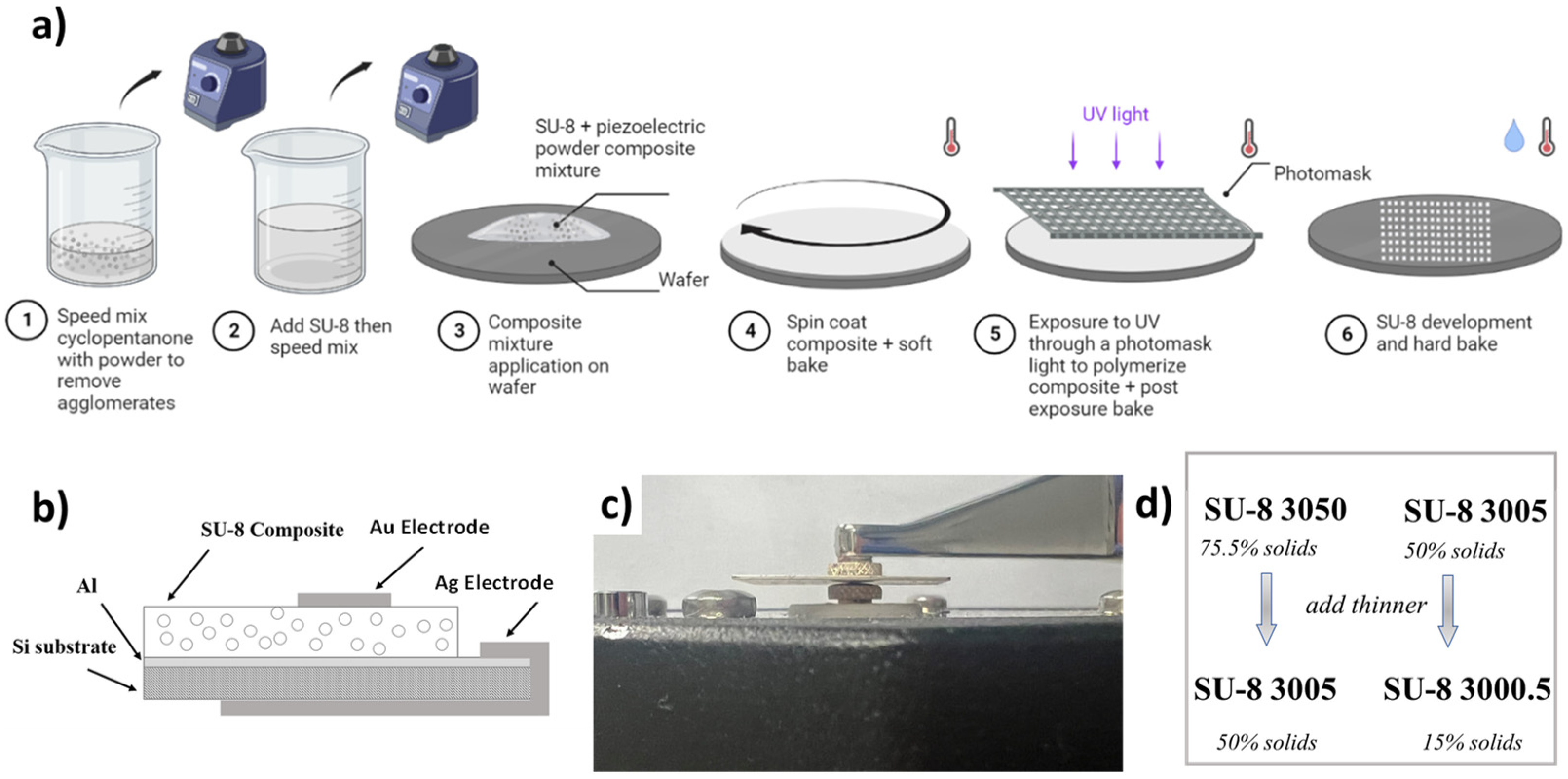



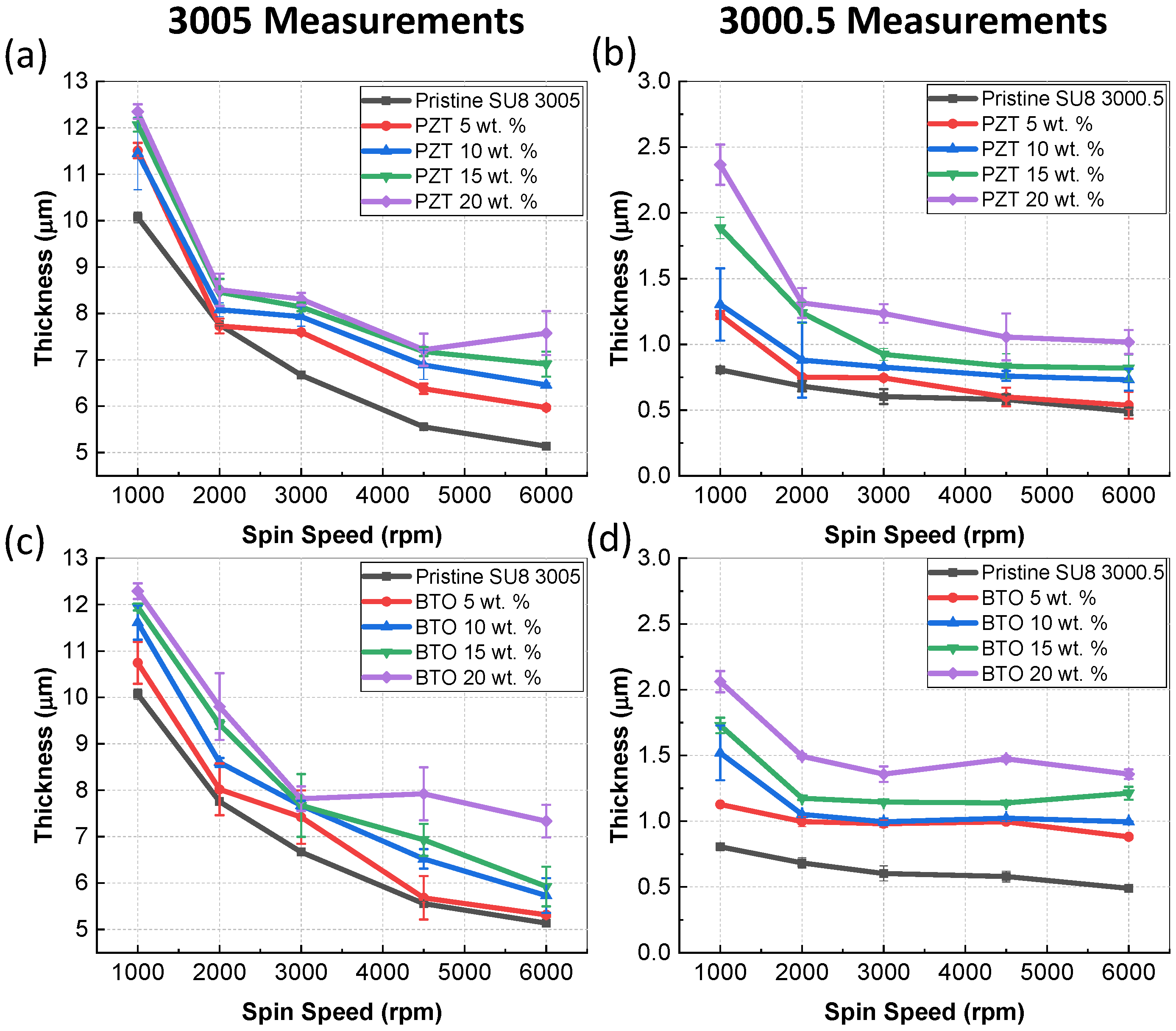
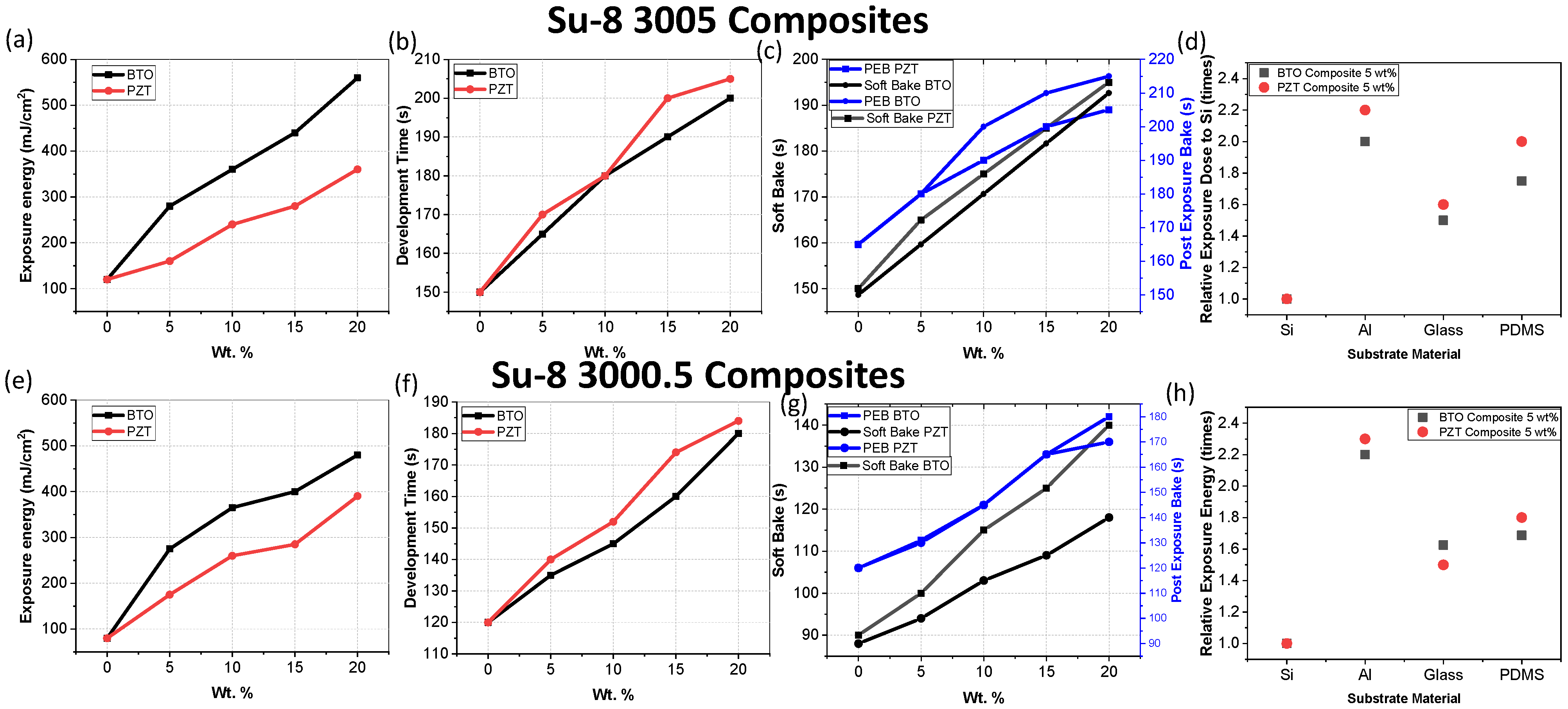
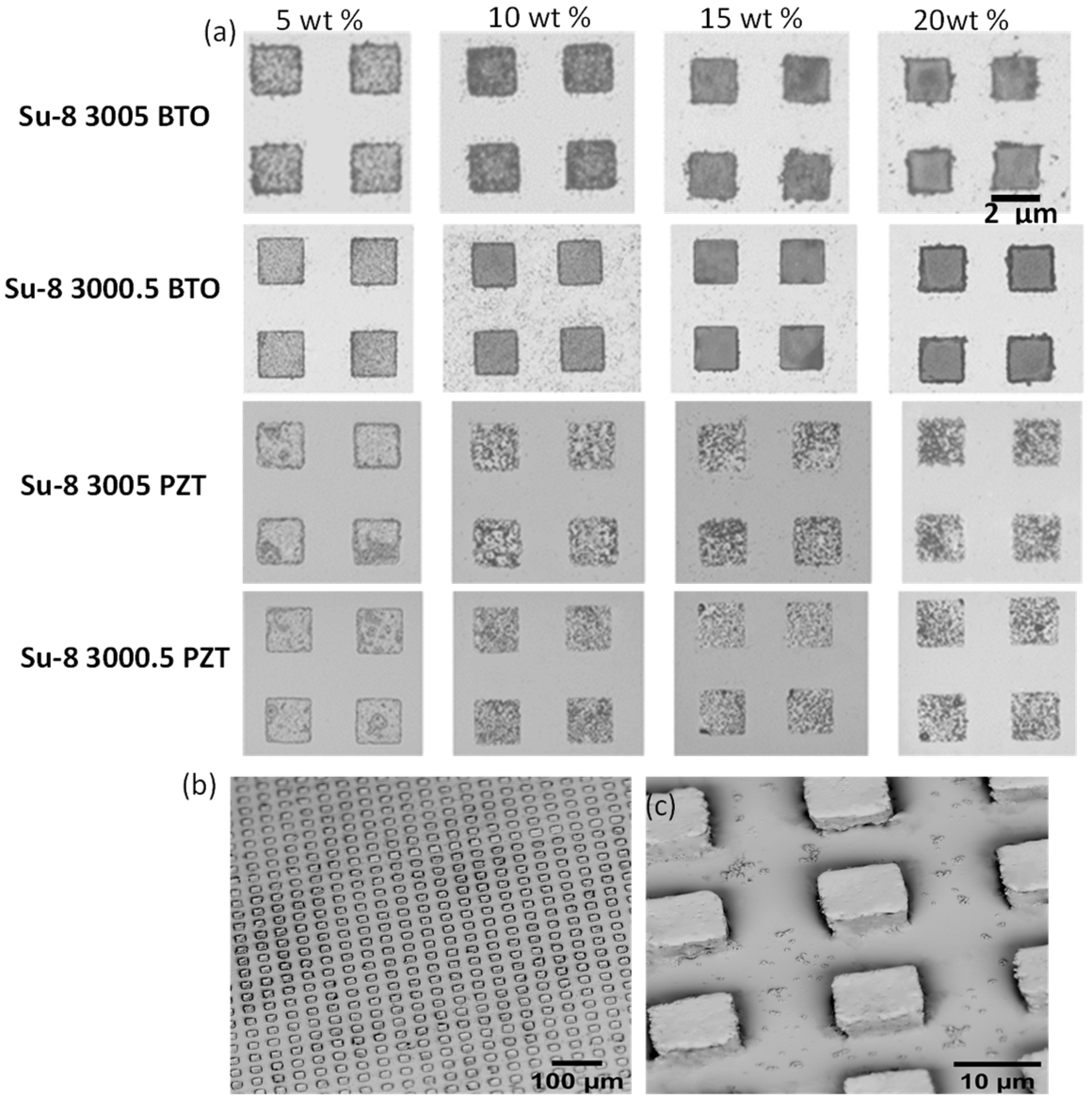

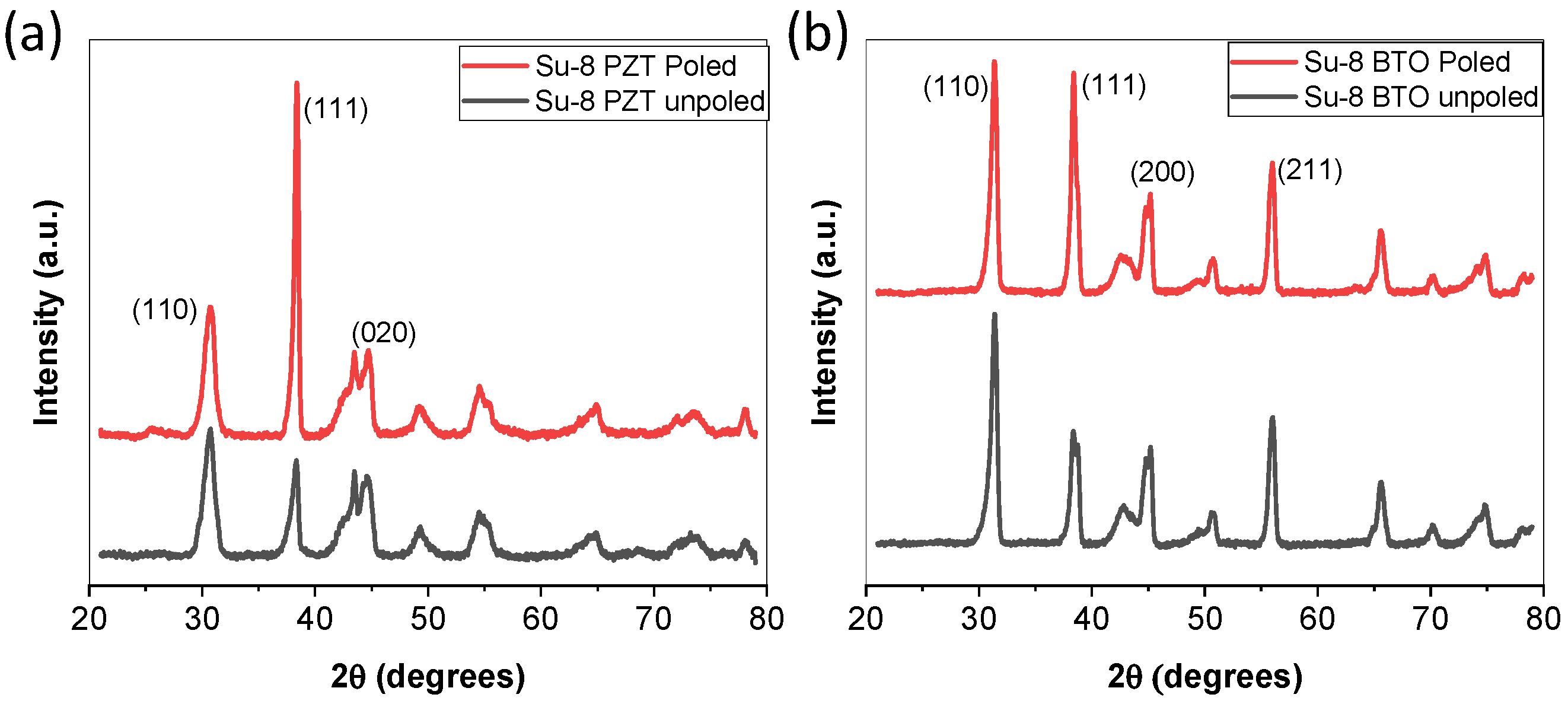
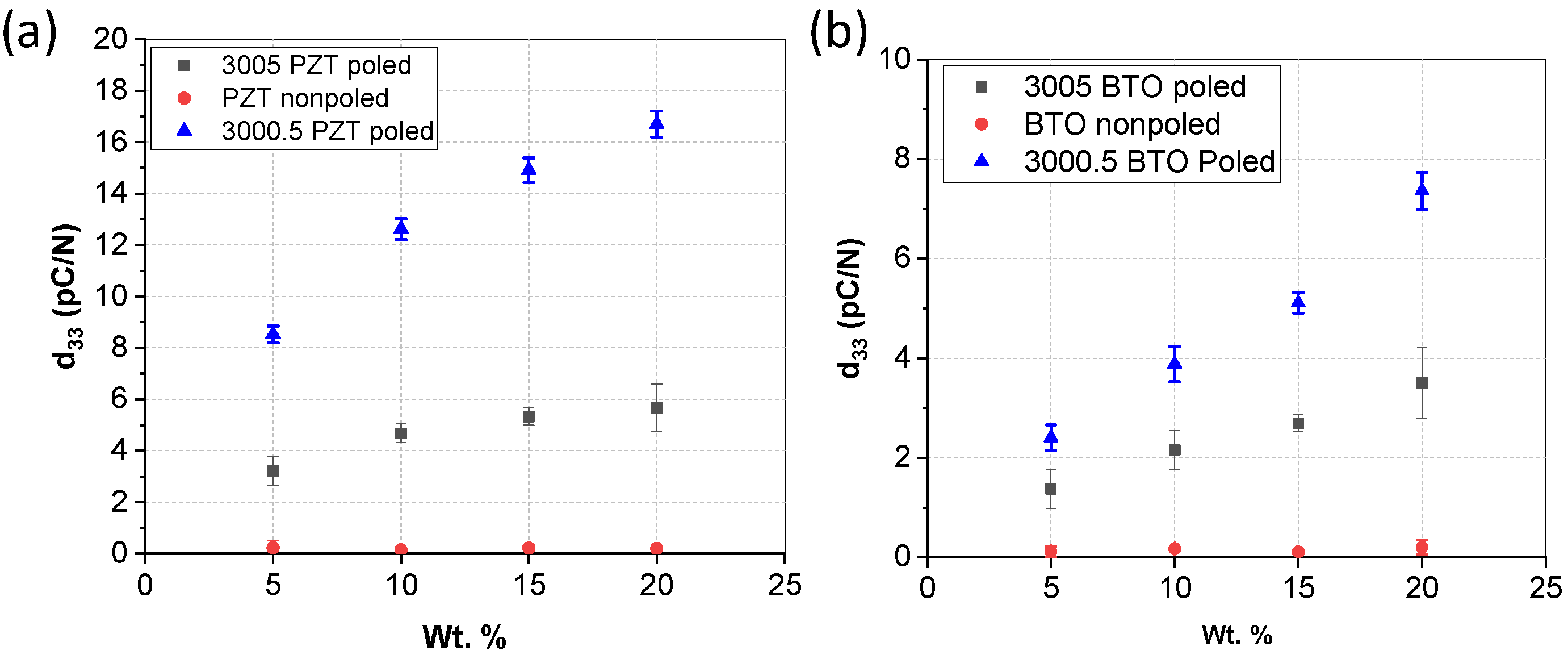

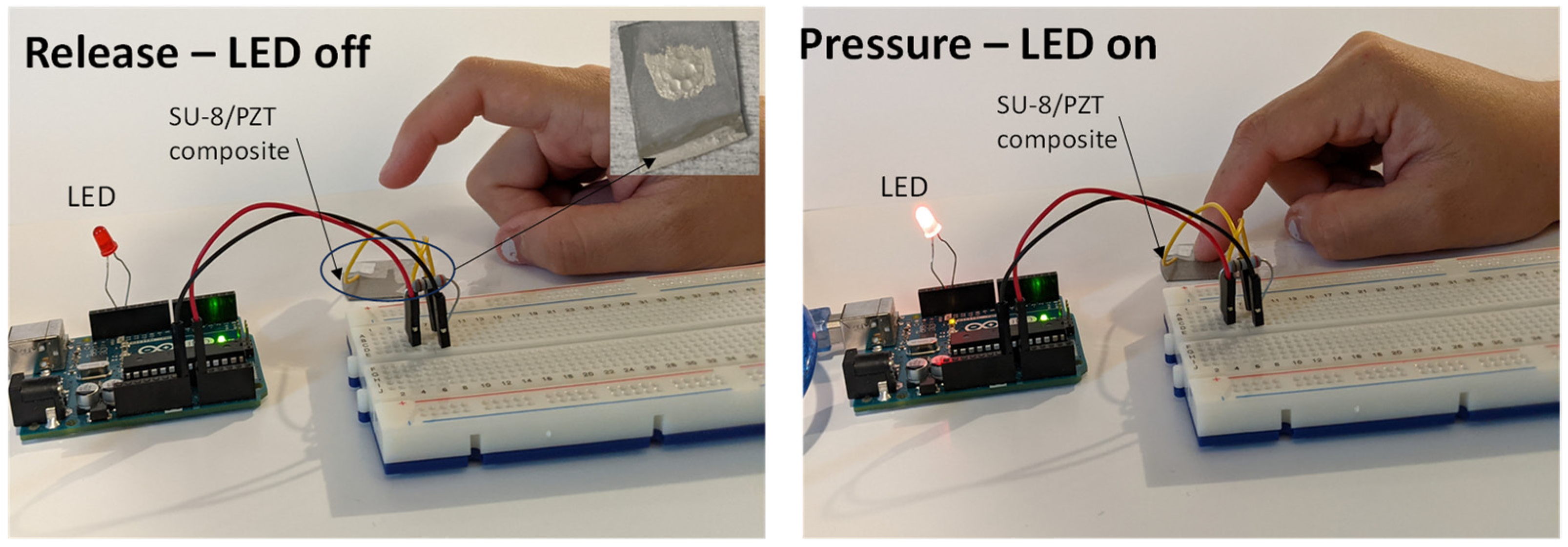
Disclaimer/Publisher’s Note: The statements, opinions and data contained in all publications are solely those of the individual author(s) and contributor(s) and not of MDPI and/or the editor(s). MDPI and/or the editor(s) disclaim responsibility for any injury to people or property resulting from any ideas, methods, instructions or products referred to in the content. |
© 2024 by the authors. Licensee MDPI, Basel, Switzerland. This article is an open access article distributed under the terms and conditions of the Creative Commons Attribution (CC BY) license (https://creativecommons.org/licenses/by/4.0/).
Share and Cite
Vazquez, I.R.; Guler, Z.; Jackson, N. Enhancing Manufacturability of SU-8 Piezoelectric Composite Films for Microsystem Applications. Micromachines 2024, 15, 397. https://doi.org/10.3390/mi15030397
Vazquez IR, Guler Z, Jackson N. Enhancing Manufacturability of SU-8 Piezoelectric Composite Films for Microsystem Applications. Micromachines. 2024; 15(3):397. https://doi.org/10.3390/mi15030397
Chicago/Turabian StyleVazquez, Irma Rocio, Zeynel Guler, and Nathan Jackson. 2024. "Enhancing Manufacturability of SU-8 Piezoelectric Composite Films for Microsystem Applications" Micromachines 15, no. 3: 397. https://doi.org/10.3390/mi15030397
APA StyleVazquez, I. R., Guler, Z., & Jackson, N. (2024). Enhancing Manufacturability of SU-8 Piezoelectric Composite Films for Microsystem Applications. Micromachines, 15(3), 397. https://doi.org/10.3390/mi15030397









